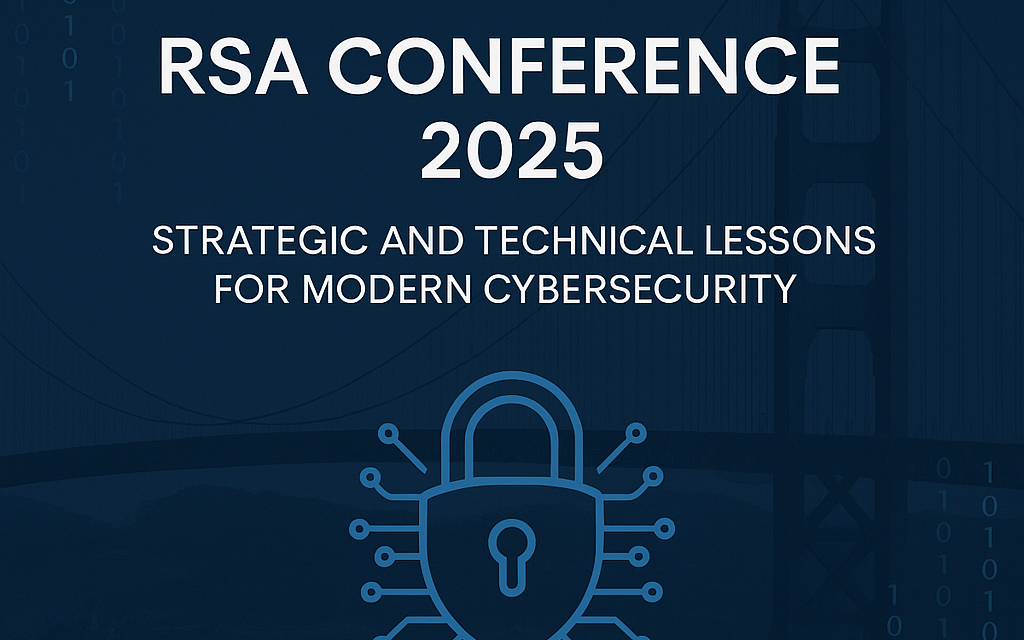From April 28 to May 1, I had the opportunity to attend RSA Conference 2025 in San Francisco, CA. Recognized as one of the most influential global events in cybersecurity, this edition not only confirmed emerging trends but also provided tangible tools to strengthen the defensive, operational, and strategic capabilities of any organization. In this article, I share a deep dive into key sessions, practical takeaways, and strategic insights relevant to CISOs, security architects, and technical teams.
Leading from Day One: How to Win Your First 90 Days as a New CISO
Russell Eubanks’ session outlined a solid structure for those stepping into cybersecurity leadership roles. He recommended acting like a consultant before the official start date—researching the company’s structure, leadership, risk assessments, and security posture. During the first 90 days, the focus should be on understanding the team, identifying quick wins, reviewing policies, uncovering gaps, and building trust. His message: don’t rush changes—first, listen, learn, and build a narrative that inspires.
AI in Cybersecurity: Opportunity and Risk
Two major themes dominated this year’s agenda: the integration of AI in cyber defense, and its malicious use by threat actors. In “AI and Cybersecurity: Shaping the Future of the Digital Economy,” experts discussed how intelligent agents can automate tasks like alert analysis, risk prioritization, and corrective action recommendations. Conversely, “The Dark Side of Innovation: Generative AI in Cybercrime” exposed how cybercriminals and nation-state actors use generative models for misinformation campaigns, deepfakes, and advanced phishing. The consensus: AI will shape the future of cybersecurity on both sides of the battlefield.
Zero Trust and Scalable Microsegmentation
In “The Journey of Enterprise Network Micro-Segmentation at Scale,” Comcast offered a masterclass on implementing Zero Trust beyond the traditional perimeter. Through their Tenant Security Framework (TSF), they showcased how to segment at the application and service level using Policy Decision Points (PDPs) and Policy Enforcement Points (PEPs). The approach reduces attack surfaces, supports data-driven governance, and enables developers to enforce policies with minimal friction. Automation and visibility were essential to scaling the strategy.
Security and Compliance by Design
In “Practical Strategies for Security Architecture in a Changing World,” Abhilasha Bhargav-Spantzel from Microsoft explained how to embed security and compliance into every stage of the software lifecycle. Using DevSecOps, continuous audits, and both static and dynamic code analysis, security becomes part of design. She highlighted standards like ISO 27001, NIST SSDF, and OWASP, and promoted a “Holistic System Thinking” mindset that considers not just software, but people, processes, and culture.
Identity as the Last Line of Defense in SaaS Environments
Aaron Turner’s session, “Identity: The Last Bastion Security Control in a SaaS World,” emphasized that identity is now the last—and often weakest—line of defense. Fragmented IdPs, legacy protocols like NTLM, and poor privileged access management increase attack surfaces. Turner recommended moving to modern platforms like Entra ID, eliminating legacy identities, and segmenting identities for admins, developers, and end users. The session also covered adaptive MFA, SSO, and the importance of discovering non-human identities.
Resilience in Times of Crisis: The Israel Case Study
One of the most human and inspiring presentations came from CYE, titled “Wartime Resilience: How a Cybersecurity Provider Stayed Strong Under Fire.” Following a 380% increase in attacks due to regional conflict, CYE activated a plan rooted in six pillars: business continuity, contextual threat modeling, continuous adaptation, human support, constant communication, and regular drills. Their response showed that technical and human resilience go hand in hand when business continuity is at stake.
Measuring Maturity with NIST CSF 2.0
John Masserini’s workshop, “Using the NIST CSF Maturity Toolkit to Evaluate Your Security Program,” introduced a practical tool for assessing cybersecurity programs. Unlike superficial compliance checks, this toolkit compares policy maturity versus actual practice. Using a five-level scale (from “Initial” to “Optimizing”), it uncovers gaps between what’s documented and what’s executed. This tool is vital for continuous improvement and for justifying cybersecurity investments.
Identity, Privilege, and Governance
Several sessions stressed the importance of access and identity governance. From reducing the number of IdPs to using PAM solutions, credentials remain a primary attack vector. In SaaS environments, app access, API integrations, and non-human identities are often overlooked. Recommendations included inventorying all identities, segmenting access by role, and removing orphan credentials.
Automation and Visibility as Enablers
From network automation in microsegmentation to AI-driven configuration drift detection, it became evident that operational efficiency increasingly depends on automating repetitive tasks and gaining continuous visibility. These enablers free up teams to focus on threat analysis, strategic planning, and red teaming.
Final Thoughts: Strategy, Technology, and People
RSA Conference 2025 reaffirmed that modern cybersecurity is not just about products. It requires a balance of strategy, technology, and people. Frameworks like Zero Trust, NIST CSF, and Secure by Design are essential—but only when implemented with vision, leadership, and cultural buy-in.
The future will demand CISOs who can turn frameworks into actions, teams that adapt to emerging threats, and organizations willing to evolve. In this dynamic environment, continuous learning and collaboration remain our most valuable assets.
Interested in implementing some of these approaches in your organization? Want to explore topics like Zero Trust, automation, or identity governance?
Share your thoughts in the comments or contact me directly. At ITGuru365, we continue to share knowledge for professionals who aim to go beyond compliance and build resilient, business-driven security.


Comments